#and don't bring up Aífe
Explore tagged Tumblr posts
Text
Aoife is one of those rare names that really there is only 1 currect spelling and that is Aoife if you are spelling it any other way it is no longer the Irish name Aoife I do make the rules
#and don't bring up Aífe#thats different#aoife is the mordern day spelling of aífe#so its different#but anyway#this is more about people who spell aoife#as aoifa#bc that is just#objectively wrong#i know what you did#you remembered that the first half of aoife#is spelt aoi#but you forgot the last half#sounded it out#and bc irish and English are 2 separate languages#you got it wrong#sorry you just did#don't go naming kids names if you cant even spell the name right#(this is a call out post for my mother the absolute cunt)
79 notes
·
View notes
Note
Hi, I don't know if this question has been asked before but what would be the reactions of the LIs if MC had a nightmare? How would they console MC?
Shae: They offer to talk about it, or get you something to help you relax and go back to sleep, like warm milk.
Keagan: Distracts you one way or another until you are ready to try and sleep again.
Aífe: She'll instruct someone to bring a draught of some fashion to help you sleep dreamlessly. If you ask, she will - with some hesitancy - sing to you as well.
Maeve: Holds you and tries to get you to talk about it. She heard if you talk about your bad dreams then they won't come true.
Flannán: He empathizes. He's no stranger to night terrors, so he is more than willing to sacrifice his sleep to comfort you through the night.
Robin: Cuddle time! They'll also assure you of their willingness to beat up dream demons if they come lurking. They're a lot scarier, after all.
***
The Good People (Na Daoine Maithe) is now out on Steam and Itch.io, and has a Kickstarter pre-launch page! Check our pinned post for details!
#ask#fate answers#na daoine maithe#the good people#otome#visual novel#dating sim#interactive fiction
47 notes
·
View notes
Text
Mortal combat between father and son
Here's a myth. It's a common myth, but not a very well known one.
A woman has a sexual liaison with a man who is travelling far from home, or he leaves her for some other reason. There may be a powerful sorceress involved too, or they may be the same woman. The man departs, but she keeps a token.
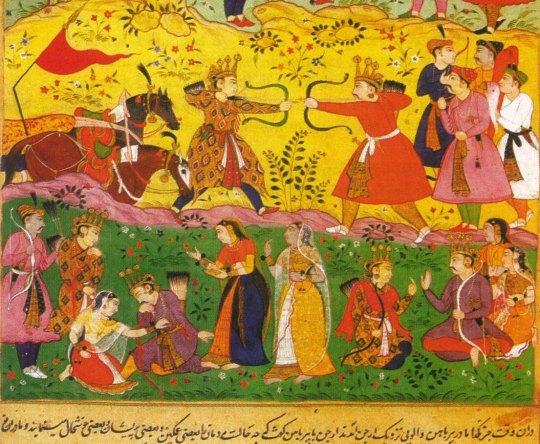
Combat between Arjuna and his son Babhruvahana. (Detail from the Birla manuscript of the Razmnama, a Persian version of the Mahabharata, 1605)
Unknown to the man, she gives birth to a son. The son grows up miraculously quickly. He asks his mother about his father, and she passes the token on to him.
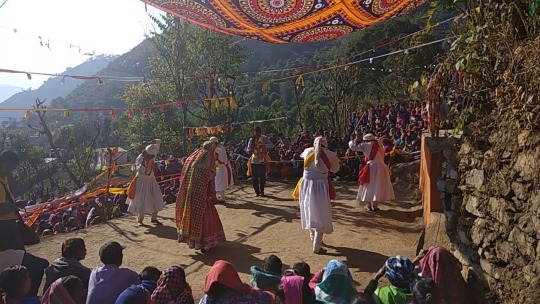
A pāṇḍav līlā dance in Garhwal, northern India, enacting the Rhinoceros Tale, in which Arjuna unwittingly kills his son Nagarjuna.
Either the son goes in search of his father, or the father returns one day. The father and son end up fighting, usually in an error of mistaken identity. One of them is mortally wounded. As he lies dying, the token is finally recognised, and they belatedly realise each other's identity.
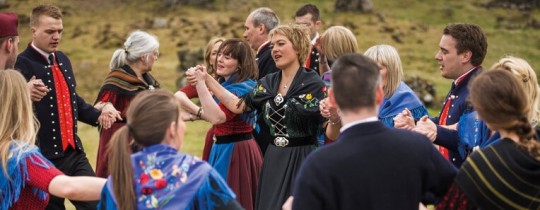
Faroese chain dance, in which the entire community sings ballads or kvæði. One such ballad is Sniolvs kvæði, in which Hildibrandur unwittingly kills his son Grímur.
But the sorceress knows of a magic that will save the dying one, or even bring him back to life after he's dead. Fetching it may involve a quest. Once the magic is fetched, it may work -- or it may be too late.
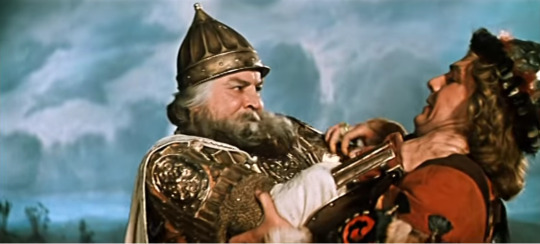
The Cossack hero Ilya of Murom fights his son Sokolnichek, as depicted in the 1956 Soviet film Ilya Muromets. In the film, Sokolnichek ends up joining his father's side; in some 19th century byliny, Ilya kills him.
This legend appears in both ancient and modern India, ancient Greece, mediaeval Ireland, mediaeval Persia, Germanic poetry, Norse saga, 19th century Russian byliny, and 18th-19th century ballads from the Faroe Islands. So it seems to be an Indo-European thing.
I'm a Hellenist, so I know the Greek variants best. Many elements don't appear in the fragments of Eugammon's Telegony, but they're there in later Greek sources: the resurrection magic is in Theon's commentary on Lycophron, the recognition token is in Dictys of Crete and in Sophocles' lost play Euryalos.
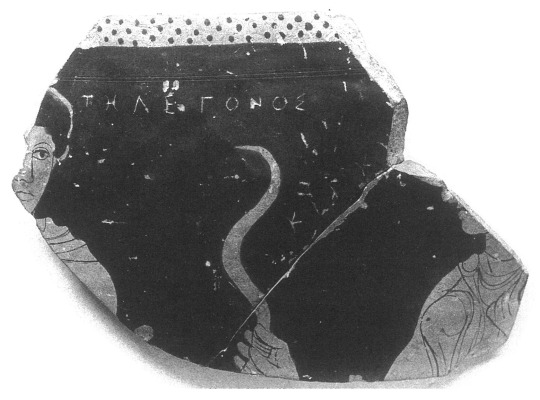
The only surviving ancient Greek image of Telegonus. Circe, right, is handing a bow to her son. (Budapest, Museum of Fine Arts 50.101; from Acrae, Sicily, ca. 400 BCE)
But the others have their fascination too. A special weapon appears in some -- Cú Chulainn's gáe bolga, Hildibrandur's sword, Odysseus' bow, Telegonus' spear. Some versions explore variations on who kills who. Ilya of Murom and Sokolnichek, and Cú Chullainn and Connla, take turns beating each other; Odysseus has three turns with three sons, with three different outcomes. The Hildebrandslied is ambiguous because its ending is missing. The relationship between the women is fascinating too: Chitrangada and the Nagini Ulupi, Circe and Penelope, Aífe and Scáthach. Some of them are just quirky: in the Jaimini-Āśvamedha (ca. 10th century), Babhruvahana beheads his father Arjuna, and when he comes back with the magic stone to revive him, the head has gone missing; so Krishna himself pops up to bring Arjuna to life. (This version also appears in the 1977 film Babhruvahana, in Kannada, starring the great Rajkumar as both Arjuna and Babhruvahana; in the film, they have a sing-off before fighting!)
It's tough to pull this material together, especially when some of the sources aren't available in a modern translation. There's no unabridged, literal translation of the Persian Shah-nameh; only parts of the Mahabharata are available in a modern translation. There's no translation at all of the Faroese Sniolvs kvæði, or of two of the Russian byliny that tell the story of Ilya and Sokolnichek. But I can still post about it on Tumblr!
#mythology#ancient greek#mahabharata#shahnameh#cu chulainn#faroe islands#russian mythology#irish mythology#icelandic sagas#german mythology#garhwal#odysseus#arjuna
82 notes
·
View notes